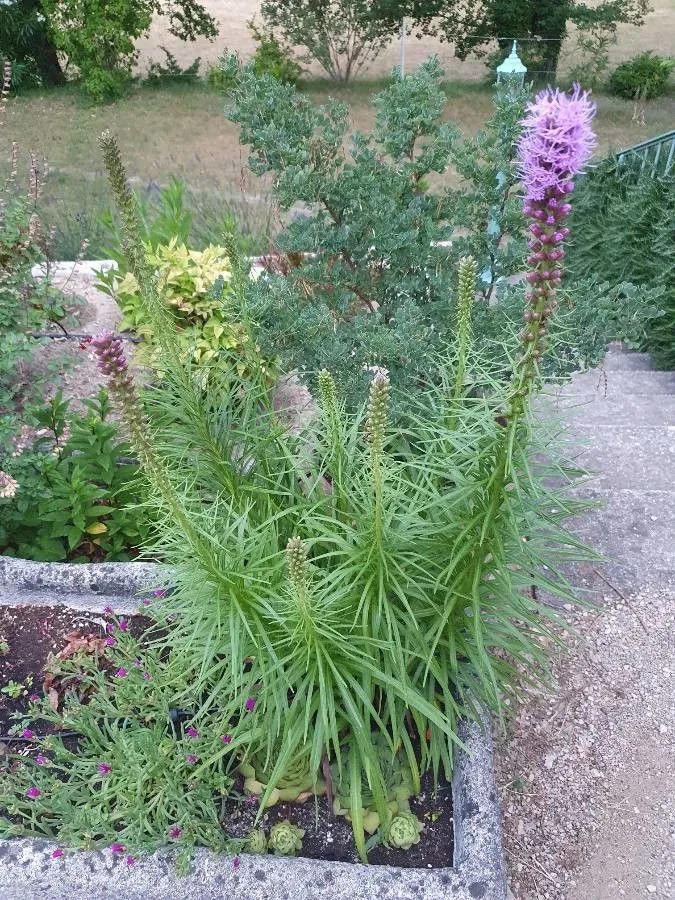
Author: Michx.
Bibliography: Fl. Bor.-Amer. 2: 92 (1803)
Year: 1803
Status: accepted
Rank: species
Genus: Liatris
Vegetable: False
Observations: SE. Canada to C. & E. U.S.A.
Tall blazing star, known scientifically as Liatris aspera, is a striking perennial herbaceous plant prized for its unique appearance and ecological benefits. Originating from southeastern Canada and extending through central and eastern United States, this distinguished member of the Asteraceae family finds its place in a variety of American landscapes.
Description and Identification:
Tall blazing star flourishes with its upright stature, reaching impressive heights that can vary from 2 to 5 feet. One of its most distinguishing features is the dense spike of vibrant purple, sometimes lavender, flower heads that adorn the top of the plant, creating a stunning vertical display. The blooms, which appear in late summer to early fall, are composed of numerous small, fluffy flowers that create a feather-like effect, enhancing the visual appeal of gardens and natural habitats alike.
The foliage of Liatris aspera is equally distinctive, consisting of linear to lance-shaped leaves that are rough to the touch, hence the species epithet “aspera,” meaning “rough” in Latin. These leaves, arranged alternately along the stem, provide a textured backdrop to the charismatic flower spikes.
Habitat and Ecology:
Liatris aspera is a resilient plant that thrives in diverse environments, ranging from prairies and meadows to open woodlands and along roadsides. It prefers well-drained soils and can tolerate drought conditions once established, making it an excellent choice for low-maintenance gardens and restoration projects. Full sun is essential for optimal growth and flowering, as it ensures the plant remains robust and less susceptible to diseases.
In addition to its ornamental value, Tall blazing star plays a vital role in the ecosystem. It serves as a valuable source of nectar for a variety of pollinators, including butterflies, bees, and hummingbirds. The plant’s presence supports biodiversity and contributes to the health of pollinator populations, which are crucial for many ecological processes.
Historical and Cultural Significance:
Recognized and described by the renowned botanist André Michaux in his work “Flora Boreali-Americana” (1803), Tall blazing star has been an object of interest for botanists and plant enthusiasts for centuries. Its historical mention underscores the plant’s significance in the natural flora of North America and its enduring appeal.
Cultivation and Uses:
For gardeners seeking to cultivate Liatris aspera, the plant can be propagated from seeds or by division of the root clumps. It is best planted in the spring or fall, and minimal care is required beyond regular watering during establishment. Once matured, Tall blazing star is notably hardy and can withstand various environmental stresses.
This plant is not only aesthetically pleasing but also practical due to its minimal maintenance needs and ecological contributions. Incorporating Tall blazing star into a garden not only enhances visual appeal but also supports local wildlife, promoting a sustainable and biodiverse environment.
In summary, Tall blazing star (Liatris aspera) is much more than just a beautiful plant; it is a symbol of resilience and ecological harmony, representing the rich botanical heritage of North America. With its striking appearance and environmental benefits, it holds a well-deserved place in both cultivated gardens and natural landscapes.
Swe: sträv rosenstav
Eng: tall blazing star, rough blazing-star, lacerate blazing-star, rough gayfeather, tall blazing-star, tall gayfeather
Fra: liatris rugueux
En: Tall blazing star, Tall gayfeather, Rough blazing-star, Lacerate blazing-star, Rough gayfeather, Tall blazing-star
Fr: Liatris rugueux
Sv: Sträv rosenstav
Taken Aug 13, 2021 by Audrey R (cc-by-sa)
Taken Aug 8, 2019 by Ludo (cc-by-sa)
Taken Jul 25, 2021 by crystals72 (cc-by-sa)
Taken Jan 3, 2020 by John Connelly (cc-by-sa)
Taken Aug 31, 2022 by Barb T (cc-by-sa)
Taken Nov 18, 2013 by EOL − Daniel Carter (cc-by-nc)
Taken Nov 18, 2013 by EOL − Ben VanderWeide (cc-by-nc)
Taken Mar 7, 2014 by EOL − Aarongunnar (cc-by-sa)
Taken Jun 17, 2021 by Bossg (cc-by-sa)
Taken Aug 8, 2019 by Ludo (cc-by-sa)
Taken Jul 22, 2020 by Michelle T (cc-by-sa)
Taken Aug 7, 2004 by EOL − Steven J. Baskauf (cc-by-nc-sa)
Taken Jan 1, 1900 by EOL − Gerrit Davidse (cc-by-nc-sa)
Taken Jan 1, 1900 by EOL − John Hilty (cc-by-nc)
Taken Aug 30, 2019 by Dan Mikal (cc-by-sa)
Taken Aug 21, 2019 by Eli Small (cc-by-sa)
Taken Aug 18, 2019 by Kulikov Ivan Kulikov Ivan (cc-by-sa)
Taken Sep 23, 2007 by EOL − Ron Thomas (cc-by-nc-sa)
Taken Aug 7, 2004 by EOL − Steven J. Baskauf (cc-by-nc-sa)
Taken Jan 1, 1900 by EOL − Gerrit Davidse (cc-by-nc-sa)
Taken Jan 1, 1900 by EOL − John Hilty (cc-by-nc)
Growth habit>: Forb/herb
Family: Myrtaceae Author: (F.Muell.) K.D.Hill & L.A.S.Johnson Bibliography: Telopea 6: 402 (1995) Year: 1995 Status:…
Family: Rubiaceae Author: Pierre ex A.Froehner Bibliography: Notizbl. Bot. Gart. Berlin-Dahlem 1: 237 (1897) Year:…
Family: Sapindaceae Author: Koidz. Bibliography: J. Coll. Sci. Imp. Univ. Tokyo 32(1): 38 (1911) Year:…
Family: Asteraceae Author: A.Gray Bibliography: Pacif. Railr. Rep.: 107 (1857) Year: 1857 Status: accepted Rank:…
Family: Fabaceae Author: Medik. Bibliography: Vorles. Churpfälz. Phys.-Ökon. Ges. 2: 398 (1787) Year: 1787 Status:…
Family: Aspleniaceae Author: (Cav.) Alston Bibliography: Bull. Misc. Inform. Kew 1932: 309 (1932) Year: 1932…